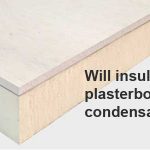The DIY Fix is reader supported. When you buy after clicking a link on our site, we may earn an affiliate commission.

Foil backed plasterboard’s are the same as a standard plasterboard, except for a thin layer of foil that is applied to the back of the board.
This foil sheet acts as a vapour barrier, it is intended to stop moisture from penetrating through the boards. Its goal is to offer a layer of protection from water that may penetrate to the internal surfaces in your home.
Foil back plasterboard’s can help to stop internal damp from occurring. However, they will not be an effective solution for all types of damp. Below is a list of situations where foil backed boards can be a good idea:
- Recently repaired damp walls – If a wall has previously suffered with damp, they may still contain moisture and salts. Applying a foil backed board in this situation will stop this trapped moisture from seeping through to your internal surfaces.
- Walls where penetrating damp is possible – Surfaces that have the potential to suffer with future penetrating damp can benefit from a vapour barrier.
- Roofs – If you are boarding an attic, foil backed boards can provide a layer of protection against small amounts of moisture entering the roof space.
- Single skin walls – Solid walls that don’t have a cavity can be prone to condensation and penetrating damp. Creating a small cavity with either a stud wall or battens and foil backed boards, can create a vapour barrier, which can act as an extra level of protection.
As you can see, foil backed boards are usually used as a preventative measure. They can add an additional layer of protection, where there is potential for small amounts of moisture.
When are foil backed boards not suitable?
A foil backed board should not be used to cover up existing cases of damp. Whilst this may stop damp showing through for a limited amount of time, it is not a long-term solution.
If your property is already suffering with damp, you will need to resolve the underlying issues first.
Once you have repaired your current damp problems, a foil backed board could be a good choice to stop trapped moisture from penetrating through later.
If you are suffering with any form of penetrating damp or rising damp, these problems will get worse over time if they are not fixed.
A foil backed board will simply cover over the problem. This could cause a whole host of future problems, including:
- A larger damp issue as the damp spreads
- Damage to structural timbers and masonry
- Mold growth
- Increased humidity causing condensation and additional damp
The important thing to remember, is a foil backed board is not a solution for damp. It is merely a way of adding a layer of protection against moisture. This means, it will only be effective against small amounts of damp.
If you do have a larger damp problem, you should locate the exact cause and repair it.
If you are unsure how to find or fix these types of problem, we advise talking to a professional.
You can do this, by getting in touch with local damp proofing experts. Most of these companies will come out and review the situation for free and offer recommendations to fix your problem.
If you use a comparison site to find these companies, you can often get multiple quotes to make sure you get the best price. Plus, any company using this type of site will have reviews and ratings on the comparison site. This way you know you are hiring good reputable companies.
If you do need some help, click here to get up to 5 local damp proofing quotes.
How to install foil backed plasterboard’s
If you have no major damp issues and are just using foil backed boards as a preventative measure, you will need to make sure you install them correctly.
The foil back on this type of board, means that you should never attempt to attach them with a drywall adhesive. These boards are not suitable for this type of installation.
You can read more about why you shouldn’t dot and dab foil backed boards here.
You will need to fix foil backed boards with screws. In most homes this will mean you are fixing to timber.
If you are fixing to roof timbers or internal stud walls, this will not be an issue. But what about solid walls made from bricks or blocks?
In this case you will need to add timber to fix too. This could be in the form of an additional stud wall, or timber battens. The option you choose will depend on several factors.
Stud wall
Pros
- Relatively quick and easy to create
- Easy to make surface plumb and flat
- Can add additional insulation
- Creates a cavity that is separate from the original wall.
Cons
- Timber will be more expensive.
- Will take up more space. Usually you will use 3 x 2-inch timber, plus cavity. This could end up over 4 inches once boarded and skimmed.
Timber battens
Pros
- Cheaper timber
- Takes up less space
Cons
- Can be more difficult to make a plumb and flat surface. This is because you are working off the original wall.
- No space for insulation. Although, you could swap foil backed boards for insulation boards.
As you can see, both options have their advantages and either will do a good job. The option you choose will depend on your own personal circumstances.
Conclusion
Foil backed boards can be a great way to add a moisture barrier to surfaces in your home. However, it is not a solution to damp.
You should only use foil backed plasterboard as a preventative measure, or in combination with other damp proofing methods. Really it should be an additional layer of protection, and not the main protection against water ingress.


